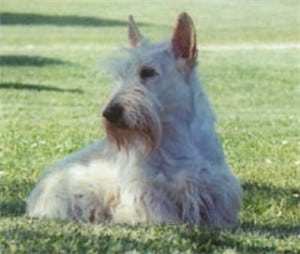From the Desk of Sharda Baker
Good day and welcome everyone!
Hello everyone!
This is Sharda again for another Scottish Terrier newsletter.
Once you have made the decision that a Scottish Terrier is the right breed for you and your family, it is important to make every effort to get a healthy dog or puppy.
There are some guidelines that you can use to help with this decision, but it is also important to make sure that you have the dog or puppy examined by your vet as soon as possible after bringing the animal home.
It is important if you already have dogs, cats or other pets at home that the new animal be separated from them until the vet check is completed.
This is good practice to prevent any spread of parasites, fleas or other disease, bacteria or viruses between the animals.
Remember that puppies have a much less developed immune system so it is critical that the puppy not be exposed to any full grown dogs that may be ill or have any conditions.
Have your existing pets’ vaccinations and vet check-ups are up-to-date before bringing a puppy into the house.
CHOOSING HEALTHY SCOTTIE ADULT DOGS
When choosing a full gown or adult Scottie check for the following:
- The eyes should be bright and deep set, not protruding, cloudy or teary.
- There should be no sign of discharge from the eyes. This will look like staining or streaking in the hair extending from the inside corner of the eye.
- The nose should be moist and cool, and there should be no discharge from the nostrils.
- The teeth should be white and not chipped or worn down. Teeth should not be missing and the gums should not be red or inflamed.
- The dog should not have foul smelling breath, as this can be a sign of digestive disorders.
- Coat should be shiny and rough to the touch, and should be free from mats or knots.
- The skin should be clean and not appear dry or flaky. There should be no “hotspots” or irritated looking areas.
- The dog should not be scratching, excessively licking or biting at its skin or hair, and should not have any patches where there is no hair or little hair.
- The dog should be lively looking and active, and should appear confident and not timid or cowed.
- The dog should respond positively to the owner or handler, and should not appear to be aggressive or bad tempered.
The owner or rescue worker should be able to give you a vet and vaccination record, as well as tell you about special considerations with the Scottie.
They may wish to give you enough dog food to allow you to feed the Scottie the food they are used to, until you are able to get some for yourself or switch the Scottie over to a brand of your preference. They should also provide a feeding schedule, to help you keep things as similar as possible for the dog during the transition.
CHOOSING A HEALTHY SCOTTISH TERRIER PUPPY
Very similar to an adult dog, the Scottish Terrier puppy should be energetic but not hyper, and be attentive to his or her surroundings.
Not a timid puppy the Scottie should be inquisitive of his or her surroundings, and should be coordinated and should not stagger or stumble when walking on a level surface.
The puppy should be eating solid food and have normal bowel and bladder elimination. Remember that small puppies will have to go frequently and will only have a small amount of urine to eliminate at a time.
The puppy should drink reasonable amounts of water, but should not drink excessive amounts or urinate too often.
Puppies that appear significantly smaller than others in the litter may have health conditions, and breeders will want to have small puppies thoroughly checked by a vet before selling them.
Scottie puppies that are timid or stay away from their brothers and sisters may lack proper socialization, and may be more difficult to work with as they get older. Over aggressive puppies, usually males, may also cause problems if they wish to dominate the family and may not be advisable for families with small children.
Always request a vet certificate with any puppy. In addition it is wise to take the puppy to your own vet as soon as possible, preferably within 72 hours, for a full physical exam.
Prior to this, keep the puppy away from other pets in the house in case there are any contagious or problematic conditions. Sometimes puppies can get fleas, and if they are too young they cannot be treated.
Parasites such as roundworms can also be a problem, so discuss this with your vet if you have concerns.
One of the best ways to choose a healthy Scottie is to make sure that they have been raised in clean, well-ventilated areas. Ask to see the kennel if possible, and make sure that it is free from dust, fecal material, or other debris.
In addition the female should look healthy, and be alert, bright-eyed, and should not be overly thin or tired looking. The mother dog should have a shiny, healthy coat, and be attentive to her puppies
A healthy mother dog indicates the puppies have been well nursed and well cared for.
Talk to the breeder about the puppies and the mother dog, and make sure all your health questions are answered before you choose a puppy.
Before leaving with your puppy make sure that you are aware of the breeder’s health guarantee and any other conditions of the sale.
Many breeders now require that you spay or neuter the puppy at a specific age and before they breed. Clarify this before purchasing the puppy, and discuss options with your breeder.
I hope you learned a lot from today’s Scottish Terrier Newsletter.
All the best and take care
Warmly,
Sharda Baker

